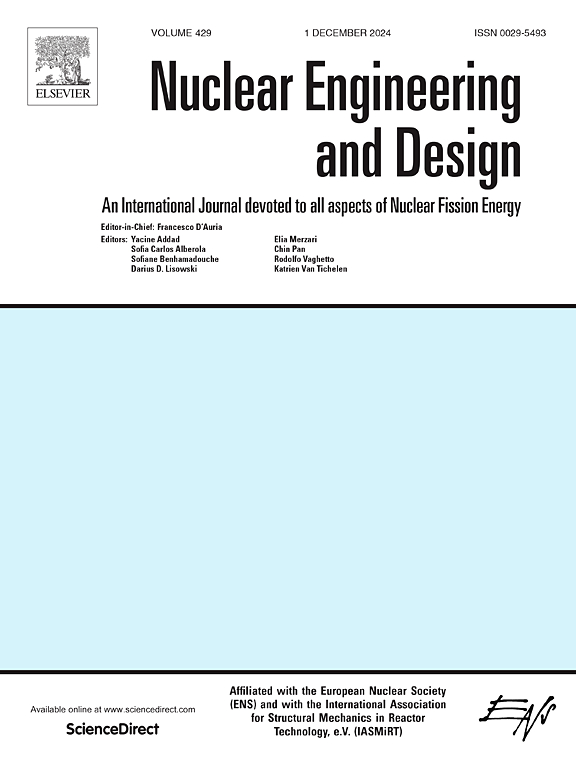Study on properties of glass fiber filter material for positive zeta potential of coolant in nuclear power plant
IF 2.1
3区 工程技术
Q1 NUCLEAR SCIENCE & TECHNOLOGY
引用次数: 0
Abstract
The microscopic particles present in the primary coolant of a nuclear power plant, when activated, have radioactivity that can affect the safety of the plant’s operation and the radiation dose of the workers. Traditional filtration materials only use mechanical interception to achieve the removal of small particles, which causes the initial filtration resistance to increase continuously, reducing the service life of the filter material. The element leaching rate is also an important indicator of the performance of the filter material. Since the filter material itself leaches Si4+, it will combine with Ca2+, Mg2+, and Al3+ ions in the coolant to form negative temperature coefficient silicates, which can form dense deposits at the hottest part of the fuel element bar, affecting the reactivity and fuel performance of the core. The leached SO42− can cause intergranular corrosion on pipe materials, which has a significant impact on the service life of equipment.
In this paper, nano-scale Al powder (50 nm) was used as raw material to successfully prepare AlOOH crystal by one-step hydrothermal method, which was grafted on the surface of glass fiber to prepare glass fiber filter material with high positive Zeta potential, and the method combining mechanical filtration and electrostatic adsorption was realized to remove small particles. At the same time, the leaching of Si4+ and SO42− was decreased. The experimental results showed that the filtration effect of the modified filter material for 0.45 μm particle size increased from 86.83 % to 99.95 %, and the 14-day Si4+ leaching concentration decreased by 73.17 % and the 14-day SO42− leaching concentration decreased by 84.43 %.
This research helps advance the development of advanced materials that can withstand the harsh environment of nuclear energy systems, providing a reliable solution to ensure coolant purity and the safety of the entire reactor.
核电厂冷却剂正zeta电位玻璃纤维过滤材料性能研究
存在于核电站一次冷却剂中的微小颗粒在被激活时具有放射性,可以影响核电站运行的安全性和工作人员的辐射剂量。传统的过滤材料仅采用机械截留来实现小颗粒的去除,导致初始过滤阻力不断增大,降低了过滤材料的使用寿命。元素浸出率也是衡量滤料性能的重要指标。由于滤料本身滤出Si4+,会与冷却剂中的Ca2+、Mg2+、Al3+离子结合形成负温度系数硅酸盐,在燃料元件棒的最热部位形成致密沉积物,影响堆芯的反应性和燃料性能。浸出的SO42−会对管道材料产生晶间腐蚀,严重影响设备的使用寿命。本文以纳米级Al粉(50 nm)为原料,通过一步水热法制备AlOOH晶体,并将其接枝到玻璃纤维表面,制备出具有高Zeta正电位的玻璃纤维过滤材料,实现了机械过滤与静电吸附相结合的方法去除小颗粒。同时,Si4+和SO42−的浸出量减少。实验结果表明,0.45 μm粒径的改性滤料过滤效果由86.83%提高到99.95%,14 d Si4+浸出浓度降低了73.17%,14 d SO42−浸出浓度降低了84.43%。这项研究有助于推进能够承受核能系统恶劣环境的先进材料的开发,为确保冷却剂纯度和整个反应堆的安全提供可靠的解决方案。
本文章由计算机程序翻译,如有差异,请以英文原文为准。
求助全文
约1分钟内获得全文
求助全文
来源期刊

Nuclear Engineering and Design
工程技术-核科学技术
CiteScore
3.40
自引率
11.80%
发文量
377
审稿时长
5 months
期刊介绍:
Nuclear Engineering and Design covers the wide range of disciplines involved in the engineering, design, safety and construction of nuclear fission reactors. The Editors welcome papers both on applied and innovative aspects and developments in nuclear science and technology.
Fundamentals of Reactor Design include:
• Thermal-Hydraulics and Core Physics
• Safety Analysis, Risk Assessment (PSA)
• Structural and Mechanical Engineering
• Materials Science
• Fuel Behavior and Design
• Structural Plant Design
• Engineering of Reactor Components
• Experiments
Aspects beyond fundamentals of Reactor Design covered:
• Accident Mitigation Measures
• Reactor Control Systems
• Licensing Issues
• Safeguard Engineering
• Economy of Plants
• Reprocessing / Waste Disposal
• Applications of Nuclear Energy
• Maintenance
• Decommissioning
Papers on new reactor ideas and developments (Generation IV reactors) such as inherently safe modular HTRs, High Performance LWRs/HWRs and LMFBs/GFR will be considered; Actinide Burners, Accelerator Driven Systems, Energy Amplifiers and other special designs of power and research reactors and their applications are also encouraged.
 求助内容:
求助内容: 应助结果提醒方式:
应助结果提醒方式:


